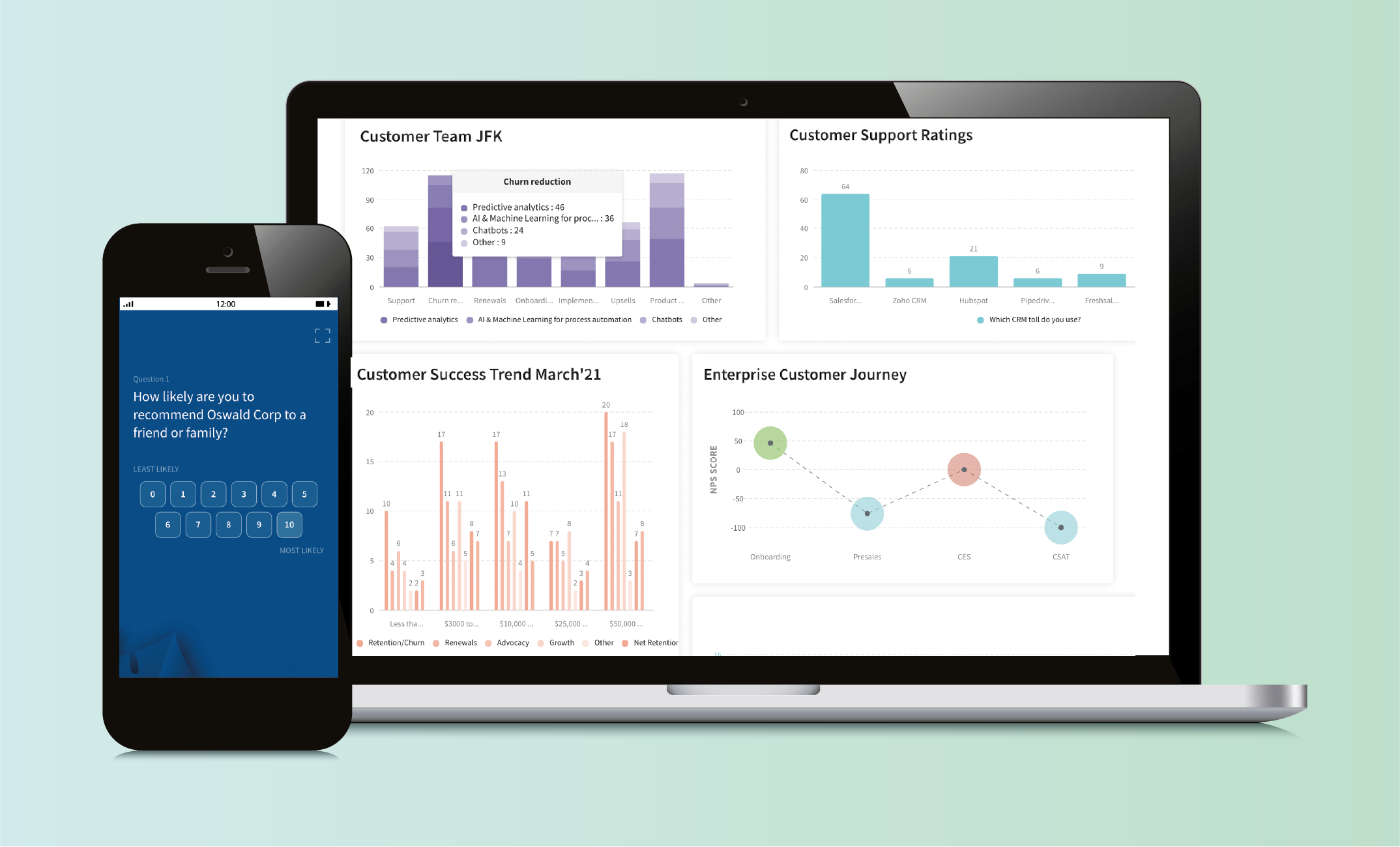Others
Top 10 Customer Onboarding Metrics to Know About in 2024
Article written by Mathew Maniyamkott
Regular contributor to various magazines. Passionate about entrepreneurship, startups, marketing, and productivity.
14 min read
19 September 2025

Looking for customer onboarding metrics to measure the effectiveness of your onboarding program?
Here are 10 customer onboarding metrics that you need to measure to know how efficient your customer onboarding process is.
- Customer Journey Mapping (and measuring)
- Time to complete onboarding
- Time to first-time value
- Free to paid conversion
- Customer progress
- Customer engagement
- Deploying specific surveys
- Escalation response time
- Average response time
- Customer churn
Different companies can have a variety of metrics. It usually depends upon their goals or the industry that they are in. But when you are setting up a customer success team, the customer onboarding metrics should be the first thing that you need to deliberate about.
1. Customer Journey Mapping
There won’t be a single user map because people are different and might use a variety of trajectories to achieve their goals.
So you need to walk through their journey to learn about the product and its benefits. You should observe where the customers drop out the first time that they are using the product.
Also, try to understand the different journeys that a user goes through to get value from your service. Can you find ways to improve this? Is it possible to shorten this journey? Identify each stage in the journey and see if there is any area that needs optimization.
Create an onboarding flow chart so that you can visually see it to find out how it can be better. Find out how you can improve these processes and see if you can implement the changes that can give better results.
SurveySparrow lets you create clean and engaging dashboards to map customer journeys with the help of powerful online surveys. Consolidate all your customer metrics and initiatives in a single view and combine insights, discover relationships, and refine the customer experience.

Explore Deeper Customer Insights with SurveySparrow
A personalized walkthrough by our experts. No strings attached!
2. Time to complete onboarding
The onboarding process should be completely focused on demonstrating how the product will help the customer. It can tell you how you can incorporate your product into their workflow so that it works seamlessly with little effort. But you should explain to them as soon as possible how they can use the product independently to get value from it.
Also, you need to measure how many days are taken for your customer to start using the product independently. Always aim for a quick onboarding process to use it as a benchmark for the future when you are creating it. Once you onboard a few clients, you will be able to know the sweet spot, and you can strive to improve on that number.
Even though you would want to reduce the time taken to onboard a customer, do remember your objective is to educate the customer about how they can effectively use the product and gain value from it.
3. Time to first-time value
You can tell your customers why your product is superior to your competitors and make them feel the same by a lot of tactics. But they need to find starting value as soon as they sign up. When is the first time your customer will find value in your product?
Time to first value is the point during the customer onboarding phase where the customer realizes that the product they have purchased has a lot of business value to them. It is the time it takes for them to achieve that.
More often than not, you will be setting up your product in their technical environment. So you may have to do the following:
- Set up users and give access rights to them.
- Integrate it with software that they are familiar with.
- Configure the product in such a way that directly helps with their business needs.
The above steps certainly don’t offer value on their own. Only when they start using the product will the customers feel it. The product should deliver the result that they want; that is when they will find value in it. You need to find out the time it takes to reach this measurable goal so that the first goal of your customer onboarding metrics is achieved within a time that you can be proud of.
4. Free to paid conversion
This is a metric that most SaaS companies should make use of.
In the subscription economy, offering a free trial for your product is a powerful marketing strategy. It allows them to use your product without having to spend a penny. If they are satisfied with the product, there is a high chance that they will use your tool by finally making a purchase.
Offering a free trial puts you in a position where you can improve your brand value as well as offer them plain value. But you need paying customers who are the lifeline for your business. The ability for you to convert your free trial customers into paid customers will be a telling sign of your success.
Have you thought about the fact that the prospects in the free trial will be already familiar with your product once they start using the free version? Then it will take you less time to help them find the first value. It is the shortest route to the onboarding process as they teach themselves how to use the product.
5. Customer progress
While you are providing training to the customer, ensure that the training curriculum is divided into various parts. Measure the time taken by the customer to complete it.
You can offer them the training using a variety of techniques. If it is a high-ticket client, then you can call them and guide them into using the product. Otherwise, you need to prepare huge stacks of content that is to be made available in different formats for all types of customers.
Make videos, write how-to articles, explain in the FAQ section, or offer them any other type of online material that they can use to self-educate themselves. The training should be made effective by addressing each of their pain points in crystal detail. You cannot leave out any issue, otherwise, it will result in them reaching out to you via email. or they might want to talk to a customer success agent. This can be stressful for your customer success team if a lot of customers want to do the same thing.
Note when each component in the training was started and completed so that you can figure out how well you are explaining each concept. Since your goal is to make the customer work directly with your product as soon as possible, this metric will help you understand if there are any issues in your onboarding process. The training should be byte-sized so that they can easily complete it.
6. Customer engagement
Once they have gone through the training manuals and have found their first value, the next step is to observe how much they are engaging with your product. It will help you be aware of issues that might happen and correct your mistakes on the go.
You need to measure how many times they log in in a day. How many of them are logging in? People who log in and use your product often mean that they are getting incredible value from it. If the number and frequency of logins are less, then you need to find out how you can help them achieve their business objectives.
- Observe the features that they are using from your product. Which is the feature that they are using the most? Which is the feature that is used the least?
- Find out which feature has a lot of time spent on it by the customers but there is little usage. It might mean that they are still not clear about how to use your product.
- If you find that the feature adoption is low, then it is time for you to be proactive and get in touch with the customers.
- At which part of the journey are the customers using specific features? Do you feel as if they are not using the product to its fullest extent? Is it possible for you to offer specific solutions on how they can get more value from it?
When we refer to customer engagement, it implies all the touchpoints inside and outside of the product. Measuring each of these touchpoints can give you an instant connection with the customers. It will put you in a position where you will be able to offer them a much better chance to operate them wisely.
7. Deploying specific surveys
Getting the feedback of your customers can help you in a gazillion ways. During the onboarding process, it will help you understand their immediate impression of your product and the brand. It will also help you figure out what they think about the customer onboarding process. You can even ask them how to make improvements to your present strategy.
There are many customer satisfaction metrics that you can use to gauge their emotions towards the customer onboarding process, product, and brand. But the best one that is available is using NPS as it tells you about their immediate feelings.
An NPS survey asks a simple question:
“How likely are you to recommend our product to a friend?”
The respondents are categorized into Promoters, Passives, and Detractors.

Promoters give you a score of 9 or 10. It means that they are happy with your product and are more likely to purchase from you in the future. They are also happy with the onboarding process based on the touchpoint where you insert the NPS question.
Passives are those who give you a score of 7 or 8 and aren’t fully committed to using your product yet. They are always on the prowl for a better product and might make the change if they find one. Based on the customer feedback, you can talk to these customers too so that you can make them become Promoter by working on their feedback.
Detractors are those who give you a score anywhere between 1 and 6. These people are not happy with your product and might make their displeasure public. Remember that they sign up to be your customer with high hopes, if you are not giving them the right treatment, they will not take it lightly.

You can boost customer loyalty and drive growth with SurveySparrow’s NPS software. Uncover real-time insights into customer satisfaction, identify promoters and detractors, and customize your strategies for enhanced customer experiences. Transform feedback into foundational strength for your brand
You might want to check NPS software for free?
14-day free trial • Cancel Anytime • No Credit Card Required • No Strings Attached
8. Escalation response time
No matter how good a customer service team or how brilliant a product is, there are bound to be mistaken. Some of these mistakes can upset the customer. More often than not, customers want immediate resolution. The way you respond to your customer complaints tells a lot about your organization as well as how much you care about your customers.
To put it in simple words, escalation response time is the time taken to resolve the complaint from the time it was logged in. Your system should track the responses and also make you aware of the escalation trends and patterns if any. If you find any patterns, it means that there is something systematically wrong that you need to take care of.
One of the first things that you need to keep in mind is that you should prioritize the escalation process when you are designing an onboarding process. Make sure that the escalation response time is as little as possible.
When there are delays in escalation response time, it directly affects the speed at which the new customers are getting educated about the product. This will also delay the time to which they will get the first value from the product.
During the onboarding process, ensure that your customer’s complaint is solved as soon as possible. It will help build trust and loyalty, and make them satisfied.
9. Average response time
Average response time is the average time taken for you to respond to the customer. You can be assured that your customers want immediate responses. If you want to make them happy and ensure that the onboarding process is a success, then you need to provide them with immediate responses.
Gone are the days when support tickets would respond saying that they will get back within 72 hours. Most companies cannot afford to do that because it can be an immediate turnoff.
Now, customers are habituated to live chats and chatbots. They want immediate responses, especially during the onboarding process where their expectations are sky-high.
However, you need to be clear with the expectations that you set with your customers when it comes to how fast they can expect a response from you.
10. Customer churn
Also referred to as the attrition rate, customer churn is the number of customers that drop your product/service. The better your onboarding process is, the lower the churn rate.
Your customers will churn when they feel as if they are not getting any value from your product, or when they don’t know how they can possibly make full use of the product. They will also leave when they are not able to realize the full potential of your product.
The onboarding process is the perfect time for you to show them the value that you offer. Make their initial experience as flawless and customer-centric as possible. Gamify the process for the customer, if possible. It will keep them engaged and they will keep coming back for more.
Ensure that your customers keep using the product and gain maximum value out of it. Otherwise, it will not help your case as your product might fall out of favor. Share relevant and informational articles with them on a regular basis, send re-engagement emails, offer them free consultation calls, etc.
All of these actions will ensure that the customer thinks about your product often so that they will use it effectively instead of trying something else.
Ready to Keep More Customers? Discover how SurveySparrow can help you identify the reasons behind churn and enable proactive retention strategies. Engage, understand, and act to turn feedback into loyalty.
Reduce Churn and Retain More with SurveySparrow. Sign up for free.
14-day free trial • Cancel Anytime • No Credit Card Required • No Strings Attached
Conclusion
If you are measuring the wrong customer metrics, you will end up wasting time, effort, and resources. But more importantly, your customer’s experience is not getting any better.
You need to measure the right metrics according to the product you sell and the customer segment that you target. At each customer touchpoint, your customer should get the best possible understanding and explanation of how everything works for them. Keep optimizing the metrics so that they will directly reflect how customers will feel.
Always try to be helpful to your customer and ensure that all of their doubts are cleared so that they understand your product completely and will be able to use it fully
Remember, there is always plenty of scopes when you are trying to provide an experience for your customer. The efficiency of your customer onboarding tactics will reflect in your churn rate, renewal rate, customer lifetime value, customer satisfaction metrics, and every other sphere that you could possibly think of.
At no point in the journey should the customer feel as if they are not being treated well. As a business, it is your duty to keep your customers happy. Having customer onboarding metrics in place and tracking them regularly is one of the most important steps towards achieving that.

Thousands of brands trust SurveySparrow to turn feedback into growth. Try it free today!
Mathew Maniyamkott
Guest Blogger at SurveySparrow
Related Articles

Others
Stepping into a new decade: What's evolving from 2010 to 2020 in SaaS
8 MINUTES
4 February 2020

Others
SurveySparrow Takes Home Two Awards!
2 MINUTES
3 January 2018

Others
How to Create a Chatbot with Little or No Programming!
9 MINUTES
2 August 2018

Others
What is the Times Interest Earned (TIE) Ratio?
12 MINUTES
17 May 2021
